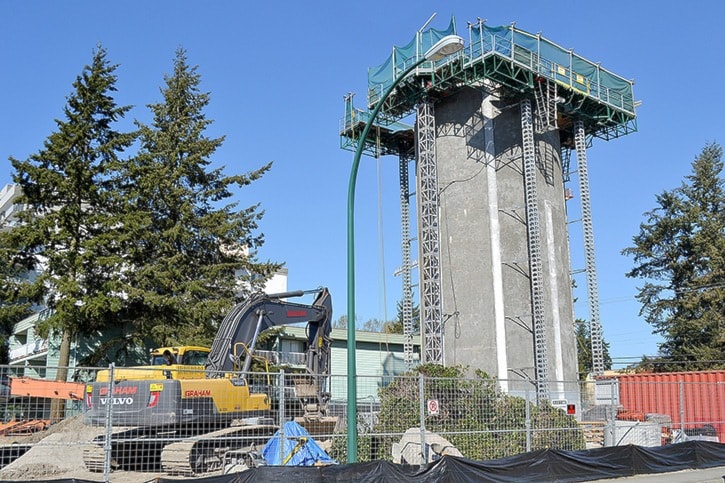Concerns about the rising arsenic and manganese content of water from White Rock taps will likely be aired in city chambers on Monday (July 25) at 4 p.m.
The City of White Rock has scheduled a special meeting for public input on a bylaw that changes its financial plan to accommodate updates on planned water-utility projects – including the building of two plants to treat city water to reduce its arsenic and manganese content.
White Rock’s city-controlled water supply is currently showing higher-than-acceptable levels of arsenic at one of the city’s six wells, according to tests published on the city’s website.
“We are aware that Well 6, at the Merklin site, is above the maximum allowable concentration level (of arsenic),” chief administrative officer Dan Bottrill told Peace Arch News.
Bottrill said while this illustrates why the city is taking action to build treatment plants, it should not be a cause for alarm among residents.
“It would be of concern if this (well) was the principal source of water that was going directly into the system, but this water is mixed in with other well waters,” he said.
White Rock’s sources of water include the Sunnyside Uplands Aquifer and the six wells. The presence of arsenic can be expected as a natural result of soil and mineral erosion, according to federal-provincial guidelines for drinking-water quality.
Most recent results of water testing published on the city’s website indicate an upward trend for both arsenic and manganese, however.
Current published figures for early May show the arsenic levels at Well 6 at .0107 mg/L – with other testing stations approaching this mark.
For the same period, arsenic detected at the Stevens sample station was approaching the limit at .0097, followed by the main shop at Buena Vista and the Merklin Low Reservoir, both at 0.0095 mg/L.
As noted in a report compiled for Fraser Health by former water utility EPCOR White Rock in April 2014, Health Canada has set the maximum allowable concentration of arsenic at 0.010 mg/L.
At this level, Health Canada pegs the risk assessment of potential excess internal organ cancers in regular water users as between three and 39 people per 100,000 population.
Bottrill said that while the city has not yet published testing figures for June, figures are typically posted in the third week of the subsequent month.
“Quite frankly, the City of White Rock has been extremely transparent in publishing all of our results.”
He added that it is hard to assess long-term rising or fluctuation of levels of metals such as arsenic and manganese in the water since EPCOR – which controlled White Rock’s water utility for a decade before the city purchased it last October – issued only annual quality statements.
“I think they were using averaging,” he said.
But Bottrill acknowledged that manganese levels in city water are running more than double the Health Canada guideline amount.
And he said that while this is only, at present, considered an “aesthetic” limit – excess manganese results in black deposits in toilet bowls, bathtubs and sinks – there is some indication Health Canada is preparing to study more harmful effects.
Manganese levels for May show the Merklin Low Reservoir registering 0.119 mg. per litre, the Stevens sample station at 0.112, the Roper PVR at 0.111 and the Russell Avenue sample station at 0.109 – all more than twice the guideline maximum level of 0.05 mg/L.
The city has opted to build two arsenic and manganese treatment plants, at the utility’s Merklin and Oxford sites – at a cost now estimated at more than $14 million, plus annual operating and maintenance costs at between $100,000 and $300,000 – with completion expected in 2019.
Consideration of the bylaw that would fund the treatment plants (which will be paid for by a combination of federal grants and long-term debt) comes amid news that Fraser Health has extended the deadline for installation of a secondary treatment system for White Rock water from June 30 until Feb. 1 of next year.
Fraser Health spokesperson Tasleem Juma said the authority’s experts now agree “that work on the effects of free chlorine on the existing distribution system requires further investigation and that is why the extension was granted.”
“This date gives them more time to evaluate the water supply modelling of the system and the need to replace any existing wells,” she said.
Bottrill acknowledged that one of the reasons for the extension is to allow time to study whether chlorination could free a buildup of arsenic deposits in aging iron pipes – which could send particles into the system and potentially increase the amount of arsenic coming out of city taps.
As highlighted in the 2014 EPCOR report, it’s a long-standing concern that far preceded the city’s purchase of the utility.
Indeed, the build up of arsenic in water-distribution systems is a long-observed North America-wide problem – as evidenced by a U.S. Environmental Protection Agency publication of April 2007 that describes “arsenic-rich scales” attaching to iron pipes.
“Certain conditions, such as flushing of mains or fire-flow conditions, may result in those scales being sloughed off.”
Bottrill said he believes the Jan. 30 deadline will allow adequate time for the city to get the results it needs.
He confirmed that the only other alternative to the city building treatment plants is to connect to Metro Vancouver’s water system, which the city says would take three to four years and cost more than $27 million – with loss of local control and an annual water cost of $1.5 million.
